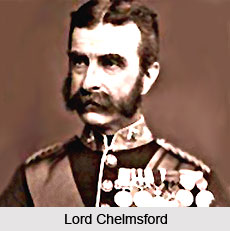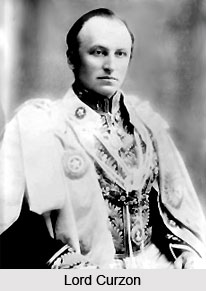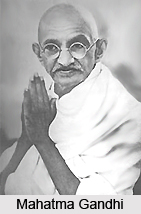 The Montagu-Chelmsford Reforms were a set of rules of betterment, introduced by the British Government in India to introduce autonomous institutions gradually to India. The reforms borrow their name from Edwin Samuel Montagu, the Secretary of State for India during the latter parts of World War I and Lord Chelmsford, Viceroy of India between 1916 and 1921. The reforms were drafted in the Montagu-Chelmsford Report prepared in 1918 and formed the basis of the Government of India Act of 1919. Indian nationalists viewed that the reforms did not stretch far enough, while British conservatives were critical of them.
The Montagu-Chelmsford Reforms were a set of rules of betterment, introduced by the British Government in India to introduce autonomous institutions gradually to India. The reforms borrow their name from Edwin Samuel Montagu, the Secretary of State for India during the latter parts of World War I and Lord Chelmsford, Viceroy of India between 1916 and 1921. The reforms were drafted in the Montagu-Chelmsford Report prepared in 1918 and formed the basis of the Government of India Act of 1919. Indian nationalists viewed that the reforms did not stretch far enough, while British conservatives were critical of them.
On 16th May 1916, based in part on the large contribution India was making to the British war effort, Lord Chelmsford concluded that a measure of constitutional advance would be necessary at the war`s termination. In consequence, he directed his Executive Council to evaluate the need and to make recommendations of change.
In July, the Viceroy`s Executive Council agreed on an advance in local government, embracing greater Indian representation in the provincial legislative councils and more extensive employment in the public services. On November 24, these recommendations were forwarded to the Secretary of State for India. On 14th August 1917, the British War Cabinet authorised the new Secretary of State for India, Edwin Montagu (1879-1924), to visit India. His inquiry was to determine the next material steps for Indian political reform.
On 20th August, Montagu announced in Parliament the British policy of seeking the greater association of the Indians in the administration of India within a context of developing institutions of self-governance. Lord Curzon was responsible for the composing of this statement. On 10th November, Montagu arrived in India with a delegation of advisors for a six-month tour and extended negotiations. From the reports and ideas he collected, Montagu formed a list of political reforms to include the concept of diarchy, or the transfer of specific powers from the Government of India to the provincial level.
On 23rd December 1919, the Government of India Act received royal assent.
Within the period of 1917 to 1919, following the Delhi Durbar of December 1911, in London the Round Table group, founded by members of Lord Milners` "kindergarten", turned to the study of imperial problems as associated with India. Lionel Curtis (1872-1955) and Philip Kerr (1882-1940), key members of the Round Table, created and developed by 1917 the concept of diarchy. This plan called for the division of India`s administrative functions between the centre and the Provincial Governments. As 1917 passed, the Curtis` plan gained more and more acceptance.
In March, the British encountered Mahatma Gandhi in the Champaran district of Northern India, investigating and articulating the case of workers who felt they had been exploited by indigo planters. Lieutenant-Governor of Bihar, Sir Edward A. Gait (1863-1950), ordered Gandhi released from jail and sought official British assistance in his investigations. Sir Frank G. Sly (1866-1928) was appointed to carry out an independent review. As a result, the Tinkathia system which forced un-remunerated labour was abolished.
Within the period of 15th June to 16th September 1917, the Government of Madras interned Annie Besant at Ootacamund (present day Ooty, Nilgiris district, Tamil Nadu) for sedition as she was seen in contacts with Indian terrorists in Bengal and due to the virulence of her newspaper, New India. This measure raised a storm of protest throughout Madras, Bombay and the Central Provinces. On her release by Lord Chelmsford, she became the President-Elect of the Indian National Congress.
 Within the days of 4th to 5th February 1918, Lord Chelmsford convened a meeting of India`s ruling princes at which the visiting Secretary of State for India, Edwin S. Montagu (1879-1924), proposed the formal establishment of a Chamber of Princes. The new body was to serve as an advisory body with direct access to the Government of India, to represent the body of princes at Imperial Conferences and to form, as necessary, commissions of inquiry and Judicial tribunes.
Within the days of 4th to 5th February 1918, Lord Chelmsford convened a meeting of India`s ruling princes at which the visiting Secretary of State for India, Edwin S. Montagu (1879-1924), proposed the formal establishment of a Chamber of Princes. The new body was to serve as an advisory body with direct access to the Government of India, to represent the body of princes at Imperial Conferences and to form, as necessary, commissions of inquiry and Judicial tribunes.
The 1919 reforms of Montagu-Chelmsford did not satisfy the least political demands in India. The British smothered opposition and restrictions on the press. Other movements were re-ordained in the Rowlatt Acts introduced in 1919. These measures were objected through the Legislative Council with the undisputed opposition of the Indian members. A number of members of the council including Jinnah quitted through protests. These measures were widely viewed throughout India as the infidelity of strong support given by the natives for the British war effort.
Gandhi launched a nationwide protest against the Rowlatt Acts, with the strongest concentration of protest in Punjab. An evidently unintentional instance of violation of rules against the gathering of people led to the Jalianwalabagh Amritsar massacre in April 1919. This tragedy stimulated such political leaders as Jawaharlal Nehru and Gandhi and the dozens who followed them to press for further action.
Montagu ordered a severe enquiry into the events at Amritsar by Lord Hunter. The Hunter Inquiry recommended that General Reginald Dyer, who commanded the troops, be fired, leading to Dyer`s sacking. Many British citizens supported Dyer, whom they considered had not met with fair treatment from the Hunter Inquiry.



















